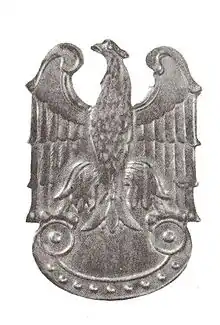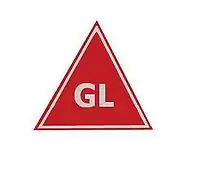Gwardia Ludowa
Gwardia Ludowa (Polish pronunciation: [ˈɡvardja luˈdɔva]; People's Guard) or GL was a communist underground armed organization created by the communist Polish Workers' Party in German occupied Poland, with sponsorship from the Soviet Union. Formed in early 1942, within a short time Gwardia Ludowa became the largest clandestine fighting force on Polish soil which refused to join the structures of the Polish Underground State loyal to the London-based government-in-exile. In the January 1 of 1944 GL was incorporated into the communist Armia Ludowa.[1]
| People's Guard | |
|---|---|
| Gwardia Ludowa | |
 Eagle of GL | |
| Active | 1942 – 1 January 1944 (transformed into People's Army) |
| Country | Poland |
| Allegiance | Polish Workers' Party |
| Role | Armed forces of the Polish Workers' Party |
| March | Marsz Gwardii Ludowej |
| Engagements | World War II Zamość Uprising Warsaw Ghetto Uprising |
| Commanders | |
| Notable commanders | Bolesław Mołojec Marian Spychalski Franciszek Jóźwiak |
| Insignia | |
| Identification symbol |  |
Gwardia Ludowa was created on 6 January 1942 with military aid from the Red Army. The availability of firearms led to GL swiftly reaching a strength of 3,000 fighters.[2] Gwardia Ludowa was connected to the NKVD intelligence services of the Soviet Union with NKVD colonels commanding some AL military actions.[3] It was tasked with fighting against Germany by means of partisan warfare, sabotage, and reprisal actions. The full size partisan detachments were formed in May 1942 although foray groups were organized earlier. They operated near Piotrków and Radom. By the end of the year the organisation was divided onto seven administrative districts including Warsaw, Lublin, Radom-Kielce, Kraków, Łódź, Silesia and Lwów.
Partisan actions
First major operations of GL consisted of disassembling train tracks. Until December 1942 some 50 railway lines were damaged resulting in 30 German supply trains being disabled.[4] Some 30 insurgents were caught and hanged,[5] but the number of units grew to over 30 in the same time.[6] The most prominent sabotage action took place on 16 November 1942 along the railway line Radom – Łuków – Terespol, where five trains and a bridge were destroyed with the use of Soviet explosives.[7] Another five trains were derailed around Oświęcim on 25 February 1943. Throughout the year, trains were damaged around Warsaw in Olszynka Grochowska, Elsnerów, Legionowo, Żyrardów and Żywczyn.[8] In total, Gwardia Ludowa caused damage to 169 trains in 1943, as well as 113 train stations, resulting in 55 temporary line shut-downs.[9]
GL retaliation actions included throwing grenades into buildings frequented by the Germans. The Apollo movie theatre in Radom was attacked on 22 November 1942; the Deutsches Haus in April 1943. In Kraków and Kielce the Nur für Deutsche coffee houses were bombed in December 1942 and February 1943 respectively.[10] The German administration building in Rzeszów was bombed also in February. Most of GL operations resulted in great number of Polish and Jewish hostages being shot by the Germans in reprisal.[11]
Field organization
GL was divided into partisan units and garrison units assembled for quick ambushes, after which the garrison members returned to their homes. By the end of 1942 GL had approximately 5,000 men, including, at least nominally, every member of the Polish Workers' Party. By late 1943 the number rose to about 10,000. Among them approximately 1,700 were partisans, and the rest were part-time combatants. For the most part, the GL carried out acts of sabotage, including the sabotage of German rail transport.
Zamość Uprising
GL took part in the Zamość uprising - a series of partisan actions against the forced Expulsion of Poles by Nazi Germany from the Zamość region.
Warsaw Ghetto Uprising
Since the formation of GL, its soldiers worked together with Jewish partisans.[12] In Warsaw, Polish communists like Józef Lewartowski were ones of the first organizers of the Jewish resistance in Warsaw Ghetto.[13] During the Warsaw Ghetto Uprising People's Guard attacked German units near the Ghetto walls[14][15] and attempted to smuggle weapons, ammunition, supplies, and instructions into the Ghetto.[16][17][18] After the uprising was over, GL helped Jews to escape Ghetto[19] and some Jewish militants joined the units of GL.[20]
Transformation
On 1 January 1944, by a decree of the Krajowa Rada Narodowa, the communist government installed by Stalin, the Gwardia Ludowa became a part of the newly formed Armia Ludowa.
Commanders
The prominent commanders and GL chiefs of staff were Marian Spychalski, Franciszek Jóźwiak, Franciszek Zubrzycki, and Mieczysław Moczar who played a prominent role in the history of the Polish People's Republic after the war's end; known for his ultra-nationalist and xenophobic attitude.[21]
Controversies
Gwardia Ludowa (GL) was commanded by the head of the Polish Workers' Party (PPR). The first commander was Bolesław Mołojec. After his execution at the end of 1942 by his own communist peers from the Polish Workers' Party, he was succeeded by Franciszek Jóźwiak. However, because of the Soviet occupation of eastern Poland in 1939–41, the Polish underground resistance never fully developed in the territories around the prewar Lwów Voivodeship area. In 1943, the command of partisan movement in General Government was passed to the Soviet partisans by Moscow.[21]
The Gwardia Ludowa military wing of PPR (with which Parczew partisans aligned themselves, for the weapons), engaged in robberies and terror expeditions aimed at local domination over the competing political structures.[22] On one occasion, the unit of Gwardia Ludowa commanded by Grzegorz Korczyński from Kraśnik County near Lublin, committed mass atrocities in the village of Ludmiłówka on 6 December 1942 killing dozens of Jews in retaliation for the PPR action in Grabówka against their own men. These murders were hushed up in Stalinist Poland by the Ministry of Public Security engaged in brutal persecution of the AK soldiers.[21]
The units of GL also fought on several occasions against the far-right Polish forces of Narodowe Sily Zbrojne.
Notes and references
- Institute of National Remembrance (March–April 2006). "Spod czerwonej gwiazdy" [Under the Red Star] (PDF). Biuletyn Instytutu Pamięci Narodowej. 3–4 (62–63). Archived from the original (PDF) on 25 August 2016. Retrieved 5 October 2016.
- Roy Francis Leslie; R. F. Leslie (1983). The History of Poland since 1863. Cambridge University Press. p. 230. ISBN 978-0-521-27501-9. Retrieved 6 January 2012.
- Chodakiewicz, Marek Jan (2004). Between Nazis and Soviets: Occupation Politics in Poland, 1939-1947. Lexington Books. ISBN 9780739104842.
- Waldemar Tuszyński, Ruch oporu w Polsce 1939–1943, KAW 1985, p. 51. ISBN 83-03-01115-4. OCLC 835891695.
- Marek Borucki, Od Mieszka I do Jana Pawła II, Tom 26, ISBN 978-83-60751-06-0. 2007 pp. 44–46.
- Tuszyński 1985, Ruch oporu w Polsce 1939–1943, p. 43.
- Tuszyński 1985, Ruch oporu w Polsce 1939–1943, p. 51.
- Tuszyński 1985, Ruch oporu w Polsce 1939–1943, p. 52.
- Tuszyński 1985, Ruch oporu w Polsce 1939–1943, p. 53.
- Tuszyński 1985, Ruch oporu w Polsce 1939–1943, p. 55.
- Tuszyński 1985, Ruch oporu w Polsce 1939–1943, p. 56.
- Nechama Tec Resistance: Jews and Christians Who Defied the Nazi Terror. University Press: Oxford 2013
- Polski Słownik Biograficzny, t. XVII, Warszawa 1972
- "Powstanie w Getcie – niewygodna pamięć". Archived from the original on 26 August 2016. Retrieved 20 October 2018.
- "Getto 1943". 18 April 2008. Archived from the original on 18 April 2008. Retrieved 20 October 2018.
- "Powstanie w Getcie". 8 April 2016. Archived from the original on 8 April 2016. Retrieved 20 October 2018.
- "Warszawa. Prosta 51". 8 April 2016. Archived from the original on 8 April 2016. Retrieved 20 October 2018.
- Polska Walcząca wobec powstania w getcie warszawskim. Antologia tekstów historycznych i literackich. "Książka i Wiedza" 2003 s. 98
- Kafka, Estera G. "Gmina żydowska - Powstanie w Getcie". poznan.jewish.org.pl. Retrieved 20 October 2018.
- "Wyszków - Wirtualny Sztetl". www.sztetl.org.pl. Retrieved 20 October 2018.
- Piotr Gontarczyk (2003). Przypadek Stefana Kilianowicza, vel Grzegorza Korczyńskiego (PDF). Z genealogii elit PZPR. Glaukopis No. 1-2003. Archived from the original (PDF) on 2015-04-08. Retrieved 4 June 2015.
- (PDF). 2015-04-08 https://web.archive.org/web/20150408025123/http://glaukopis.pl/pdf/1/artykul-4-1.pdf. Archived from the original (PDF) on 2015-04-08. Retrieved 2018-04-02. Missing or empty
|title=(help)